The world’s largest moose vs. a hungry mountain lion. Who wins? Ordinarily, you’d think the mountain lion’s got this one, right? They’re predators, and moose are gentle giants. But this isn’t just any moose we’re talking about. This moose is the biggest in the world, with the strength to kick down trees. It’s not about to become some mountain lion’s lunch without a fight. Follow along to see who the winner will be.
World’s Largest Moose
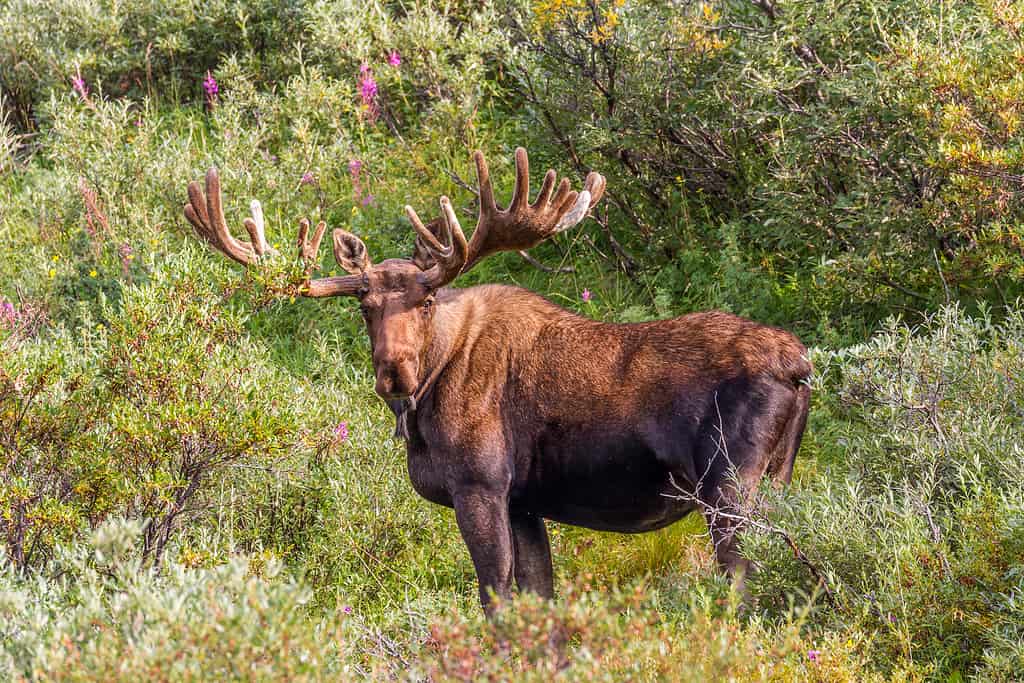
The world’s largest moose on record weighed an astonishing 1,808 pounds.
©JacobLoyacano/Shutterstock.com
The hungry mountain lion isn’t fighting any old moose. For today’s animal battle, they’re fighting the world’s biggest moose on record, and it’s humongous. The heaviest moose ever weighed 1,808 pounds. This Alaskan moose stood 7.6 feet tall at the shoulder, a record that remains unchallenged to date.
Even an average-sized moose is much bigger than a mountain lion. Moose are the world’s largest deer species and North America’s tallest mammal. They can stand neck to neck with a grizzly and tower over a horse. The average male Alaskan moose is roughly 1 foot taller at the shoulders than an average thoroughbred horse. As for bison, these tall creatures share comparable heights averaging around 6.5 feet at the shoulder.
What Eats Adult Moose?
Adult moose don’t have to worry much about in the predator department. They’re just too big! These wise mammals live an average of 10 to 25 years, munching their way through the forests. Mountain lions might prey on young, old, or sick moose; healthy adults are generally too much of a challenge to target. Despite their poor eyesight, moose have excellent hearing and a keen sense of smell. Plus, moose can kick a predator to death. A powerful kick from a moose can break bones and snap necks. And if their hooves don’t win the battle, their massive antlers will.
Hungry Mountain Lion
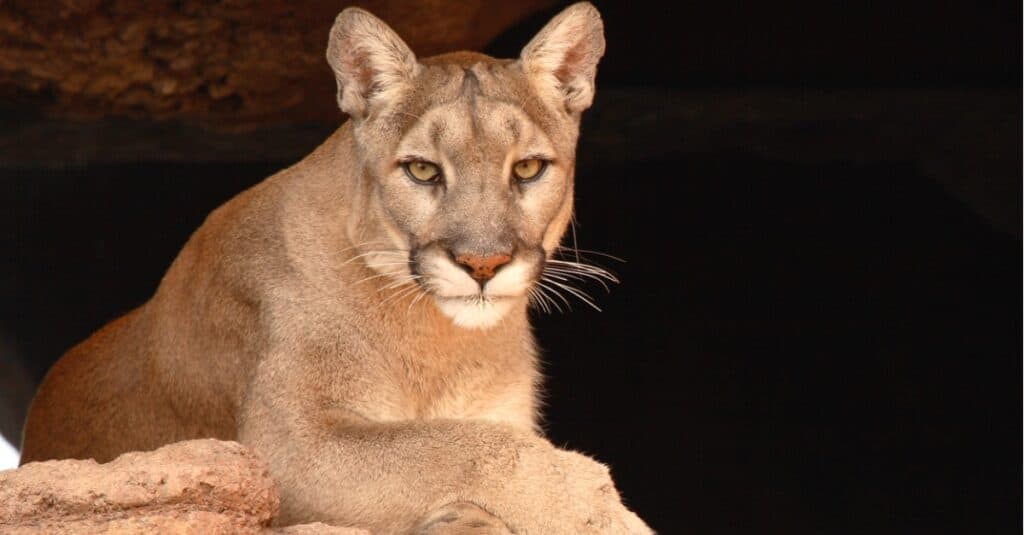
After making a kill, mountain lions start devouring prey stomachs first.
©iStock.com/gatito33
Following a kill, mountain lions usually begin eating the stomach first. They can consume up to 30 pounds of meat in a single sitting. When they’re full, they try to cover the uneaten portion with debris. Then they can return to their rotting stash for leftovers. Sometimes they keep returning to the same cache for as long as 10 days.
In the United States, two distinct populations of mountain lions exist. The Florida panther is a subspecies of the mountain lion in the Florida Everglades. There’s also a broader population scattered throughout the western mountainous regions. Mountain lions need a stable population of large prey like deer and plenty of space to roam. Overlapping territories can lead to deadly confrontations. Their territories can vary greatly, ranging from 25 to 700 square miles.
Average Sizes

Mountain lions can weigh over 200 pounds and can stand 30 inches at shoulder height.
©Scott E Read/Shutterstock.com
On average, mountain lions are 6 to 8 feet long and have a shoulder height between 20 to 30 inches. Males weigh between 115 and 220 pounds; females weigh between 65 and 140 pounds. And while this is big, the wild cat’s stats aren’t anything compared to a massive moose.
Moose generally have a shoulder height of 5 to 6.5 feet and weigh between 800 and 1,200 pounds. The Alaska Yukon Moose is the largest, with individuals weighing over 1,800 pounds, while the East Siberian Elk can exceed 1,600 pounds. In comparison, the Yellowstone Moose and the Amur Moose are the smallest subspecies in North America. Each specie’s antlers, indicative of their health and age, are influenced by diet and can become unbelievably large. The world’s largest moose had antlers 6 feet and 3 5/8 inches.
Are Moose Peaceful Creatures? Or Born Fighters
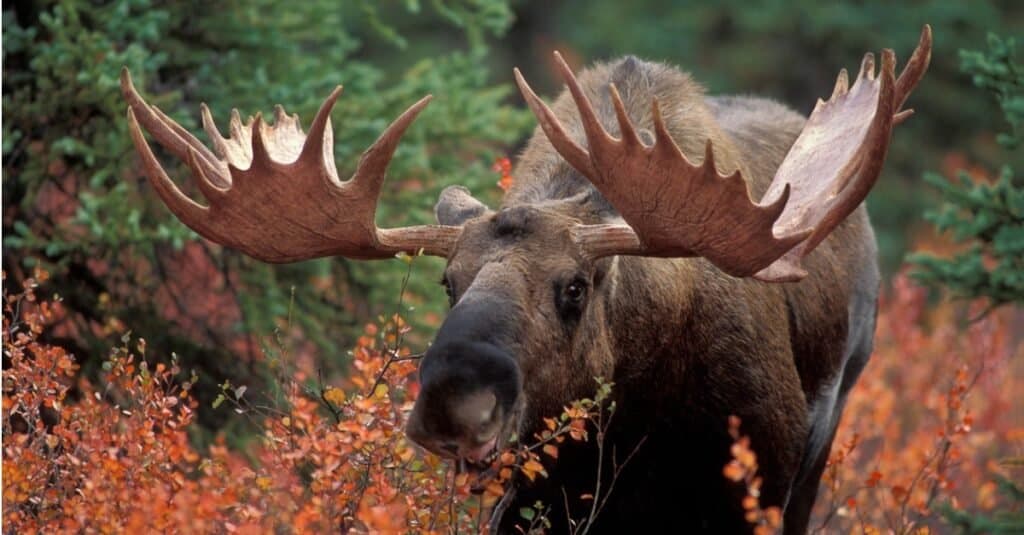
Moose are usually peaceful creatures but will react aggressively if threatened.
©iStock.com/RONSAN4D
While typically peaceful, moose can become aggressive under specific circumstances. They’re especially moody when exhausted from trekking through snow. In Alaska, more people are injured by moose than by bears. Sometimes it’s the result of someone pelting the moose with snowballs. A moose can also be dangerous if it feels threatened or if a human inadvertently gets between a mother moose and her calf. The mountain lion is fighting a large male moose for today’s animal match-up. But what if it was going up against a mother moose? How might that change things?
Mountain Lion vs. Mother Moose
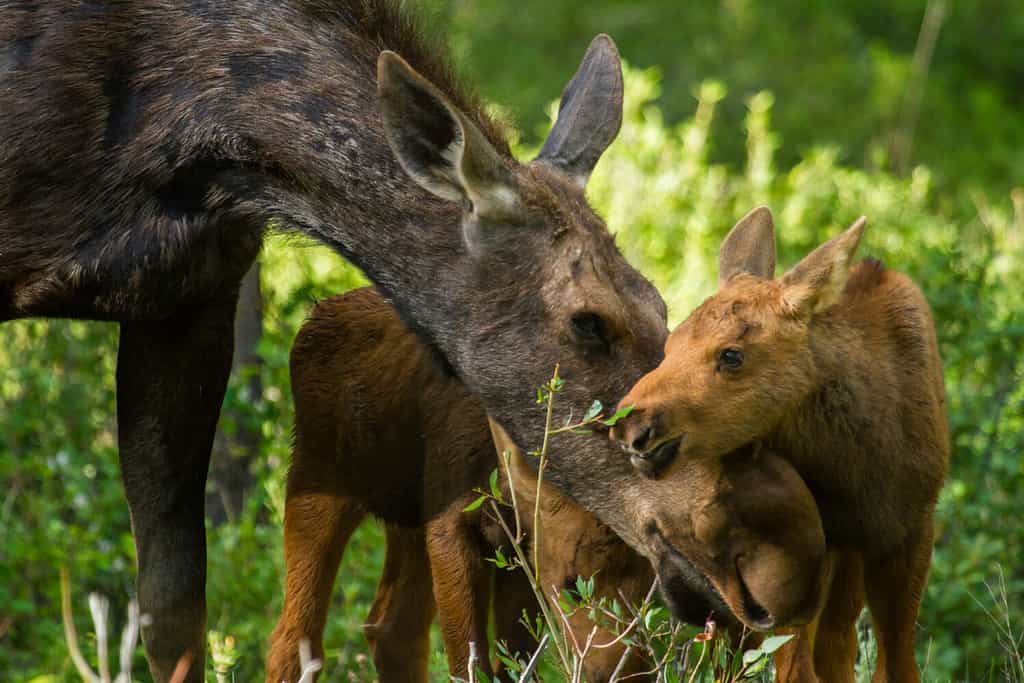
Like bear moms, a moose mother is fiercely protective of her calf.
©Green Mountain Exposure/Shutterstock.com
If the hungry mountain lion upsets a tired mother moose, things will heat up fast. Moose are usually safe from predators, but babies or calves are a different story. Moose calves are vulnerable to a variety of predators in their early life stages. They’re particularly vulnerable the first few weeks after birth since their so small and weak. They only weigh about 30 pounds at birth; if they’re from a twin set, they can weigh as little as 14 pounds.
Key predators primarily include wolves, black bears, and grizzly bears. Wolves can single out a moose calf, separating it from its mother. As can black bears and hungry grizzlies. Before they can run around, they’re sitting targets. Thankfully, within three days, these calves can run at speeds averaging around 30 miles per hour. Plus, the calves have their moms to help them fight. If a mountain lion challenges a moose mom, it’ll have a big fight on its hands. Moose moms charge full force at potential threats.
Fighting Style: Moose vs. Mountain Lions

Mountain lions have long, fang-like teeth that can measure over an inch long.
©Chris Alcock/Shutterstock.com
What’s the moose’s secret to survival? Knowing how to kick. Moose use their strong hind legs for defensive purposes, predominantly kicking and stomping when confronted by predators such as bears and wolves. They’re capable of kicking in any direction to protect themselves.
Although they may lack the kicking power of a moose, mountain lions can inflict a lot of damage with a powerful swipe, followed by a slash and bite. This competitor possesses razor-sharp claws that can reach up to 2.5 inches in length. They also have fang-like teeth, which measure about 1.5 inches long. Both their teeth and claws are designed for piercing and grasping prey. These skilled predators know how to sneak attack and could surprise an unsuspecting moose. But would they?
Chances of a Fight
Mountain lions can take down a moose under the right circumstances. The wild cat stands a chance if the moose is old, sick, or injured. The odds of an attack go up if the deer are scarce, making the mountain lion more desperate and hungry. Mountain lions primarily feed on deer but can and do take larger prey, including elk and moose. So simply put, it’s possible a mountain lion would attack a moose. But the odds of them attacking a healthy moose are low.
More About Moose Fights
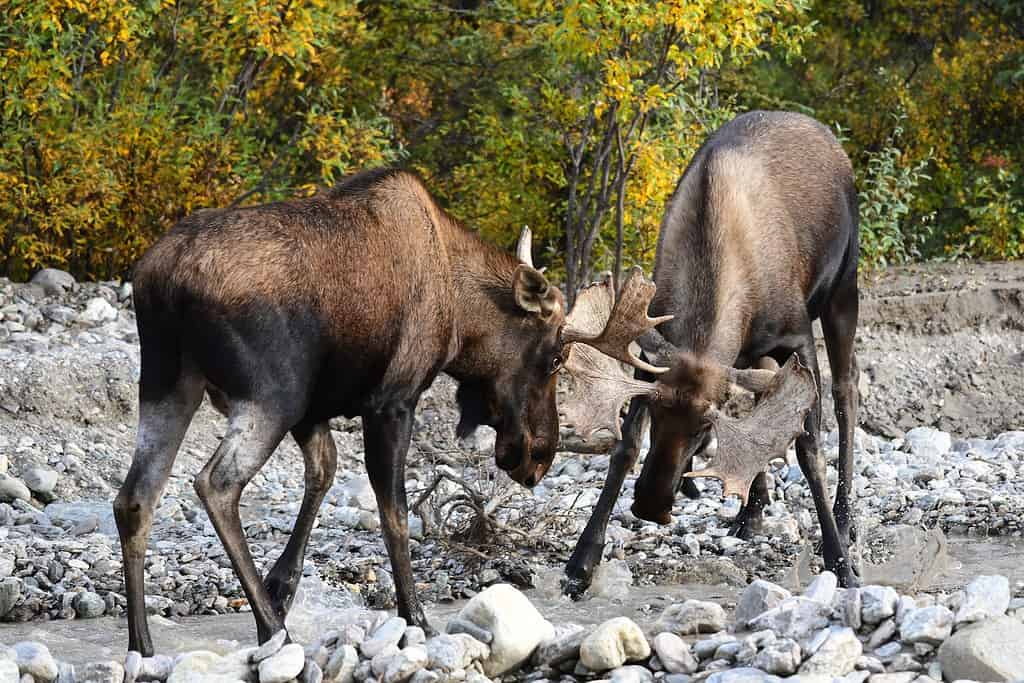
Moose practice sparring to learn their strength and prepare for real fights.
©JT Fisherman/Shutterstock.com
Moose don’t just kick and butt heads; they even engage in “boxing.” This is where they stand on their hind legs and strike opponents with their front legs. Bull moose are remarkable fighters. They can weigh up to 1,600 pounds, and their neck muscles double in size during the rutting season. Disputes often involve kicking, stomping, or boxing.
Young bulls can be seen fighting each other, but their spats are much less intense. Sparring among bull moose is a common sight. It’s a learning opportunity for young bulls to assess their strength by locking antlers and pushing against each other.
Actual fights among mature bulls can become life-threatening. Dominance in fights determines mating rights, as the victorious bulls get a higher chance of controlling female groups and passing on their genes. There can be impressive displays of power, such as pawing the ground, thrashing antlers against shrubs, and showcasing their bodies.
Who Wins?
The moose wins, and here’s why. Although a mountain lion can kill a young or sick moose, a healthy, fully-grown moose has more power with its size and powerful antlers. And in this particular match-up, the sizes are really lopsided. The world’s biggest moose weighs 1,808 pounds and towers over the 2-foot-tall mountain lion.
Here’s how the battle plays out. Using their ambush hunting skills, the large cat waits for the right moment to pounce. Mountain lions typically aim for the head or neck, an attack that usually proves successful, but not today. Even a well-landed bite won’t be enough to win this fight. Feeling the pierce of the mountain lion’s fangs, the moose reacts with full force. They use their antlers and supreme kicking skills to overpower the mountain lion.
The photo featured at the top of this post is © Tom Tietz & Evgeniyqw/Shutterstock.com
Thank you for reading! Have some feedback for us? Contact the AZ Animals editorial team.







